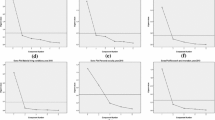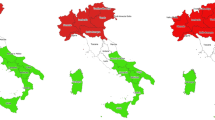Abstract
This article studies convergence across Italian regions by means of two composite indicators of socio-economic progress reflecting the multidimensional nature of human well-being. The first composite indicator includes, other than household disposable income in Italy, two sub-indicators regarding health and education; the second composite indicator considers, in addition to those considered by the former, three further sub-indicators relating to the quality of the socio-institutional context, age and gender disparities in the labor market and regional competitiveness. The data base of the 17 variables or indexes used to construct the six abovementioned sub-indicators cover the period from 1998 to 2008. We assess the existence of both σ and γ- convergence; the latter computed by means of Kendall′s index. Consistent with the findings in other European countries that also use composite economic and quality of life indicators we find evidence of regional σ-convergence in well-being, but do not observe significant processes of intra-distributional mobility. In other words, while dispersion across Italian regions in terms of well-being levels declined in the period, the regional ranking remained substantially unchanged.



Similar content being viewed by others
Notes
The total number of variables considered in the analysis amount to eighteen if we include per-capita GDP.
The logarithmic transformation is a strictly concave function that allows us to take some account of the distributive effects. In fact, “the average of the logarithms of incomes tends to increase as the given total income is more equally distributed” (Anand and Sen, 1994, p.4). “Income is quintessentially a means to other ends. The case for a distribution-sensitive measure of incomes can, therefore, be very firmly linked both with the efficiency and equity arguments for equality. A more equal distribution of income would generate more desirable ends (such as utilities, capabilities, and so on), but can also serve to bring about a more equal distribution of this end-variables, given a homogeneous population” (ibidem, pp. 3–4).
For the sake of brevity, we do not report correlations between the variables used for the construction of the six sub-indicators. The analysis of correlations between variables showed, however, the absence of relevant links (i.e. the values are less than or equal to 0.7).
The letter R before the name of the variable indicates its scaled value for each region j and time t. This also applies in the following expressions.
In constructing the competitiveness index our objective was to capture as much as possible both the regional potential to compete, as well as its actual performance in foreign markets. A number of studies develop composite indexes of competitiveness combining input and output sub-indicators (see, among others, Schwab and Porter, 2007; IMD, 2008; Huggins and Davies, 2006; Annoni and Kozovska, 2010).
In Italy, the National Institute of Statistics (ISTAT) and the Department for Development Policies and Economic Cohesion of the Ministry of Economic Development (DPS) have signed numerous conventions and agreements to produce a spatial data base at regional and sub-regional levels to provide territorial statistical information for structural policies (see www.Istat.it).
Marchante et al. (2006) included two components in the education index: the adult literacy rate indicator and the mean years of schooling of the working age population indicator assigning them weights, respectively, equal to 2/3 and 1/3.
We refer to the scaled value of GDP for each region j and time t in a similar way to the other indicators considered in the analysis.
V ij = R ij(t=2008)-R ij(t=1998). Remember that R ij(t) is the value obtained after the original variable i has been normalized.
In particular, it is distinguished from convergence estimated by means of the so-called “Barro regressions”, which basically consist in regressing the growth in the variable of interest (for example per-capita GDP) on its initial level for a given cross-section of countries or regions within countries. According to this methodology, convergence occurs if the coefficient of the initial level of the variable of interest is negative and statistically significant (Barro 1991,1997; Barro and Sala-i-Martin 1991; Mankiw et al. 1992). A critique to this methodology can be found in Friedman (1992) and Quah (1993,1996).
Boyle and McCarthy (1997) show that the absence of σ-convergence does not imply absence of γ-convergence.
References
Anand, S., Sen, A. (1994). Human Development Index: Methodology and Measurement. United Nations Development Programme (Human Development Report Office, New York) Occasional Papers 12.
Annoni, P., & Kozovska, K. (2010). EU Regional Competitiveness Index 2010. EUR: European Commission, Joint Research Centre. 24346.
Banca d’Italia. (2010). Mezzogiorno e politiche regionali. Roma: Seminari e Convegni.
Barro, R. J. (1991). Economic growth in a cross-section of countries. Quarterly Journal of Economics, 106, 407–443.
Barro, R. J. (1997). The determinants of economic growth: A cross country empirical study. Cambridge: The MIT Press.
Barro, R. J., & Sala-i-Martin, X. (1991). Convergence across States and Regions. Brooking Papers on Economic Activity, 1, 107–158.
Boyle, G. E., & McCarthy, T. G. (1997). A simple measure of β-convergence. Oxford Bulletin of Economics and Statistics, 59, 257–264.
Calderon, C., Chong, A., & Galindo, A. (2002). Development and efficiency of the financial sector and links with trust: cross–country evidence. Economic Development and Cultural Change, 51, 189–204.
Capriati, M. (2011). Spesa pubblica e sviluppo umano nelle regioni italiane. QA. La Questione Agraria, 2, 23–56.
Commission of the European Communities (2009). Communication from the Commission to the Council and the European Parliament, Brussels.
Costanza, R., Hart, M., Posner, S., Talberth, J. (2009). Beyound GDP: The Need for New Measures of Progress. The Pardee Papers, January 4, Boston University.
Felice, E. (2007). I divari regionali in Italia sulla base degli indicatori sociali (1971–2001). Rivista di Politica Economica, 3–4, 359–405.
Fleurbaey, M. (2009). Beyond GDP: the quest for a measure of social welfare. Journal of Economic Literature, 4, 1029–1075.
Franco, D. (2010). L’economia del Mezzogiorno. In Banca d’Italia, Il Mezzogiorno e la politica economica dell’Italia, (pp.1–16), Workshop and Conferences, 4, Roma, www.bancaditalia.it
Friedman, M. (1992). Do old fallacies ever die? Journal of Economic Literature, 4, 2129–2132.
Giannias, D., Liargovas, P., & Manolas, G. (1999). Quality of life indices for analysing convergence in the European Union. Regional Studies, 33, 27–35.
Guiso, L., Sapienza, P., & Zingales, L. (2004). The role of social capital in financial development. American Economic Review, 3, 526–556.
Hanushek, E. A., & Wößmann, L. (2007). Education quality and economic growth. Washington: The World Bank.
Harmoon, C., Oosterbeek, H., & Walker, I. (2003). The returns of education: microeconomics. Journal of Economic Surveys, 2, 115–155.
Huggins, R., Davies, W. (2006). European Competitiveness Index 2006-07. University of Wales Institute, Cardiff – UWIC: Robert Huggins Associates Ltd. http://www.cforic.org/downloads.php
IMD. (2008). World competitiveness yearbook 2008. Lausanne: Institute for Management Development.
Iuzzolino G., Pellegrini G., Viesti G. (2011). Converegence Among Italian Regions, 1861-2011, Economic History Working Papers, Banca d’Italia, 22, www.bancaditalia.it
Jones, C. J., Klenow, P. J. (2010). Beyond Gdp? Welfare Across Countries and Time. National Bureau of Economic Research, Working Paper 16352, Cambridge, MA, September.
Kakwany, N. (1993). Performance in living standards. An international comparison. Journal of Development Economics, 41, 307–336.
Kennedy, R. (1968). Speech at the University of Kansas. 18 March, Kansas.
Kuznets, S. (1934). National Income, 1929–1932. Senate document N. 124, 73d Congress, 2d session.
Mankiw, G., Romer, P., & Weil, D. N. (1992). A contribution to the empirics of economic growth. Quarterly Journal of Economics, 107, 407–437.
Marchante, A. J., Ortega, B., & Sànchez, J. L. (2006). The evolution of Well-Being in Spain (1980–2001): a regional analysis. Social Indicators Research, 2, 283–316.
Mazumdar, K. (1999). Measuring the well-being of the developing countries: achievement and improvement indices. Social Indicators Research, 1, 1–60.
Nordhaus, W. D., & Tobin, J. (1973). Is growth obsolete? New York: Columbia University Press.
O’Leary, E. (2001). Convergence of living standards among Irish regions: the role of productivity, profit outflows and demography, 1960–1996. Regional Studies, 3, 197–205.
OECD (2011) Compendium of OECD well-being indicators. www.oecd.org.
Quah, D. T. (1993). Galton’s Fallacy and tests of the convergence hypothesis. The Scandinavian Journal of Economics, 95, 427–443.
Quah, D. (1996). Empirics for economic growth and convergence. European Economic Review, 6, 1353–1375.
Sala-i-Martin, X. (1994). Regional cohesion: evidence and theories of regional growth and convergence. European Economic Review, 6, 1325–1352.
Sala-i-Martin, X. (1995). The classical approach to convergence analysis. The Economic Journal, 106, 1019–1036.
Sapienza, P., & Zingales, L. (2011). Trust and finance. NBER Reporter, 2, 16–19.
Schwab, K., & Porter, M. E. (2007). The global competitiveness report 2007-2008. Geneva: World Economic Forum.
Sen, A. (1985). Commodities and capabilities. Amsterdam: North Holland.
Sen, A. (2000). Development as freedom. Oxford: Oxford University Press.
Siegel, S. (1956). Nonparametric statistics for the behavioral sciences. New York: McGraw-Hill.
Stiglitz, J., Sen A., Fitoussi J.P. (2009). Report by the Commission on the Measurement of Economic Performance and Social Progress, Paris.
UNDP. (1990). United nations development programme, human development report. New York: Oxford University Press.
UNDP. (2010). United nations development programme, human development report. New York: Oxford University Press.
Author information
Authors and Affiliations
Corresponding author
Additional information
Senior authorship is equally shared. We wish to thank Vincenzo Carrieri and two anonymous referees of this journal for their helpful comments on an earlier draft of the paper.
Appendix
Appendix
Statistic variables used for the construction of the data-base
Rights and permissions
About this article
Cite this article
Ferrara, A.R., Nisticò, R. Well-Being Indicators and Convergence Across Italian Regions. Applied Research Quality Life 8, 15–44 (2013). https://doi.org/10.1007/s11482-012-9180-z
Received:
Accepted:
Published:
Issue Date:
DOI: https://doi.org/10.1007/s11482-012-9180-z




